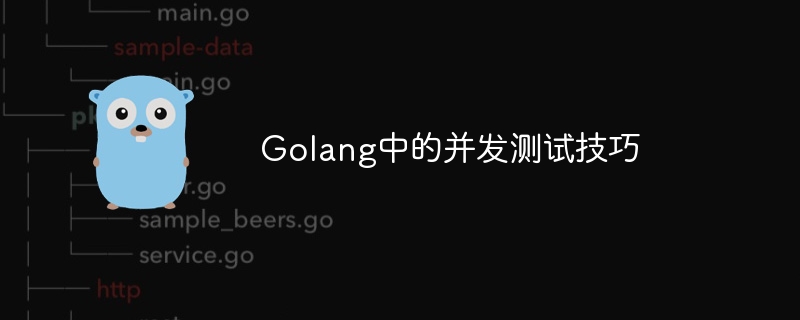

Concurrency testing skills in Golang
Introduction:
Concurrency is an important concept in modern software development, which allows programs to perform multiple tasks at the same time. Improve program performance and responsiveness. In Golang, concurrency is achieved through a combination of goroutines (lightweight threads) and channels (used to pass data between goroutines). This article will introduce some techniques for concurrency testing in Golang and provide corresponding code examples.
1. Use WaitGroup for concurrent waiting
In Golang, when we need to wait for all goroutines to be executed before performing subsequent operations, we can use WaitGroup in the sync package. WaitGroup is a counter that waits for the execution of a group of goroutines to complete.
Code example:
package main
import (
"fmt"
"sync"
)
func main() {
var wg sync.WaitGroup
wg.Add(3)
go func() {
defer wg.Done()
// 第一个goroutine的代码
fmt.Println("goroutine 1")
}()
go func() {
defer wg.Done()
// 第二个goroutine的代码
fmt.Println("goroutine 2")
}()
go func() {
defer wg.Done()
// 第三个goroutine的代码
fmt.Println("goroutine 3")
}()
wg.Wait()
// 所有goroutine执行完毕后进行后续操作
fmt.Println("所有goroutine执行完毕")
}2. Use Mutex for concurrent access control
In concurrent testing, sometimes we need to control goroutine's access to certain shared resources. Golang provides the Mutex type in the sync package for implementing mutex locks. By using Mutex, we can ensure that only one goroutine can access shared resources at the same time, thus avoiding data competition problems.
Code example:
package main
import (
"fmt"
"sync"
)
var count int
var mutex sync.Mutex
func main() {
var wg sync.WaitGroup
wg.Add(3)
go func() {
defer wg.Done()
for i := 0; i < 1000; i++ {
mutex.Lock()
count++
mutex.Unlock()
}
}()
go func() {
defer wg.Done()
for i := 0; i < 1000; i++ {
mutex.Lock()
count--
mutex.Unlock()
}
}()
go func() {
defer wg.Done()
for i := 0; i < 1000; i++ {
mutex.Lock()
count += 2
mutex.Unlock()
}
}()
wg.Wait()
fmt.Println("count的最终值:", count)
}3. Use Select for concurrent operation selection
In Golang, by using the select statement, we can select one from multiple channels for operation. This is very useful in concurrency testing and can handle various concurrency scenarios.
Code example:
package main
import (
"fmt"
"time"
)
func main() {
ch1 := make(chan int)
ch2 := make(chan string)
go func() {
time.Sleep(2 * time.Second)
ch1 <- 1
}()
go func() {
time.Sleep(3 * time.Second)
ch2 <- "hello"
}()
select {
case <-ch1:
fmt.Println("ch1已接收到数据")
case <-ch2:
fmt.Println("ch2已接收到数据")
}
}Conclusion:
By using WaitGroup for concurrent waiting, Mutex for concurrent access control, and Select for concurrent operation selection, we can better perform concurrency in Golang test. These techniques can help us optimize the performance of the program, and the code examples for concurrent testing can also help readers better understand and apply these techniques. I hope that readers can better master the concurrency testing skills in Golang through the introduction and examples of this article, and further improve their abilities in concurrent programming.
The above is the detailed content of Concurrency testing techniques in Golang. For more information, please follow other related articles on the PHP Chinese website!
 How to define variables in golang
How to define variables in golang
 What are the data conversion methods in golang?
What are the data conversion methods in golang?
 What are the commonly used libraries in golang?
What are the commonly used libraries in golang?
 What is the difference between golang and python
What is the difference between golang and python
 Usage of promise
Usage of promise
 How to use dict function in Python
How to use dict function in Python
 There is an extra blank page in Word and I cannot delete it.
There is an extra blank page in Word and I cannot delete it.
 Windows cannot access shared computer
Windows cannot access shared computer
 The difference between mongodb and mysql
The difference between mongodb and mysql




